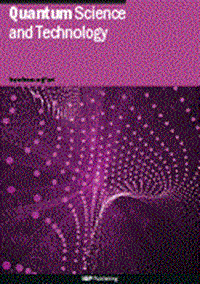量子线性系统的预条件分组编码
IF 5
2区 物理与天体物理
Q1 PHYSICS, MULTIDISCIPLINARY
引用次数: 0
摘要
像量子奇异值变换(QSVT)这样的量子线性系统求解方法需要在酉算子UA内对系统矩阵a进行分块编码。不幸的是,分组编码通常会导致显着的亚归一化和矩阵有效条件数κ的增加,从而影响求解器的效率。矩阵预处理是一种成熟的经典技术,通过将a乘以预条件p来降低κ。在这里,我们研究了分组编码的量子预处理。我们考虑了四种前置条件和两种编码方法:(a)分别对a及其前置条件P进行编码,然后进行量子乘法,以及(b)在UPA编码产品之前将a和P经典相乘。利用计算流体动力学(CFD)中的实用矩阵分析了它们对亚归一化因子和条件数κ的影响。我们的研究结果表明(a)量子乘法引入了过多的次归一化因子,否定了κ的改善。我们研究了预放大量子乘法来减少次归一化。相反,我们看到(b)使用带填充的稀疏近似逆预条件对经典积进行编码可以显著提高有效条件数。此外,我们还引入了一种新的矩阵滤波技术,可以在不影响矩阵解的情况下减少电路深度。对于大小为1024 × 1024的示例CFD矩阵,我们应用这些方法将QSVT相位因子的数量减少了25倍。本文章由计算机程序翻译,如有差异,请以英文原文为准。
Preconditioned block encodings for quantum linear systems
Quantum linear system solvers like the quantum singular value transformation (QSVT) require a block encoding of the system matrix A within a unitary operator UA. Unfortunately, block encoding often results in significant subnormalisation and increase in the matrix’s effective condition number κ, affecting the efficiency of solvers. Matrix preconditioning is a well-established classical technique to reduce κ by multiplying A by a preconditioner P. Here, we study quantum preconditioning for block encodings. We consider four preconditioners and two encoding approaches: (a) separately encoding A and its preconditioner P, followed by quantum multiplication, and (b) classically multiplying A and P before encoding the product in UPA. Their impact on subnormalisation factors and condition number κ are analysed using practical matrices from computational fluid dynamics (CFD). Our results show that (a) quantum multiplication introduces excessive subnormalisation factors, negating improvements in κ. We study preamplified quantum multiplication to reduce subnormalisation. Conversely, we see that (b) encoding of the classical product can significantly improve the effective condition number using the sparse approximate inverse preconditioner with infill. Further, we introduce a new matrix filtering technique that reduces the circuit depth without adversely affecting the matrix solution. We apply these methods to reduce the number of QSVT phase factors by a factor of 25 for an example CFD matrix of size 1024 × 1024.
求助全文
通过发布文献求助,成功后即可免费获取论文全文。
去求助
来源期刊

Quantum Science and Technology
Materials Science-Materials Science (miscellaneous)
CiteScore
11.20
自引率
3.00%
发文量
133
期刊介绍:
Driven by advances in technology and experimental capability, the last decade has seen the emergence of quantum technology: a new praxis for controlling the quantum world. It is now possible to engineer complex, multi-component systems that merge the once distinct fields of quantum optics and condensed matter physics.
Quantum Science and Technology is a new multidisciplinary, electronic-only journal, devoted to publishing research of the highest quality and impact covering theoretical and experimental advances in the fundamental science and application of all quantum-enabled technologies.
 求助内容:
求助内容: 应助结果提醒方式:
应助结果提醒方式:


